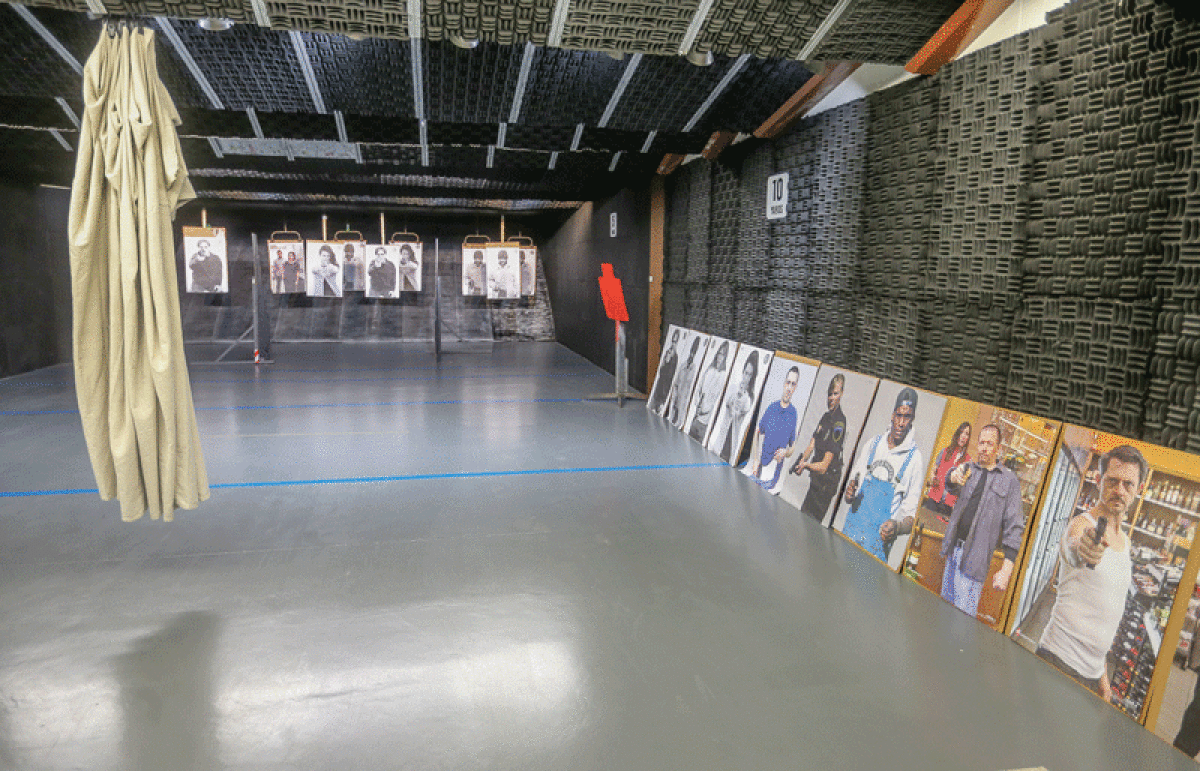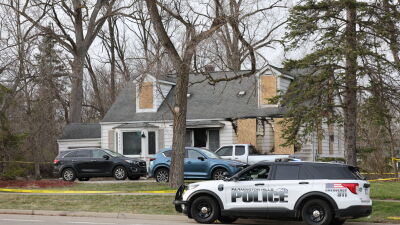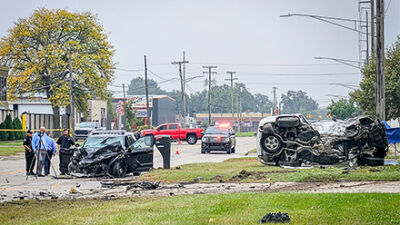FARMINGTON HILLS — An attorney based in Southfield said she was contacted in May by the family of a Cub Scout who toured the Farmington Hills Police Department.
As part of the tour, the Cub Scouts were shown an area where officers partake in training exercises.
One aspect of the training involves situational awareness and threat assessment, in which officers are faced with cutout images of actual people to help determine whether or not a situation is a threat — and do so quickly.
The individuals in the cutouts hold different items, which can vary from a cellphone to a can of soda pop to actual weapons.
The idea is to assess which of the images pose a threat and which do not, and in an environment where there’s not a lot of light, from yards away.
According to attorney Dionne Webster-Cox, on the day the Cub Scout troop visited the Farmington Hills Police Department, the only images shown were of Black males.
According to her, the family who contacted her “couldn’t believe what they saw.”
“On that day, the only images that were shown were of Black men. That’s it,” Webster-Cox said.
Webster-Cox said she is a spokesperson on behalf of a family that took photos on the day of the visit.
Farmington Hills Police Chief Jeff King said he was not present during the Cub Scout visit and only learned that there had been some controversy associated with it “after the attorney from Southfield had a press conference.”
King later learned that it was a parent of one of the Cub Scouts who took the photos.
After the allegations came to light, the Farmington Hills Police Department sent out a press release.
“Despite the allegations, the demographics of the Police Department’s human targets are as follows: eleven Caucasians (85%) and two African-Americans (15%), all presented as a threat and non-threat target,” the release states. “The Police Department’s targets are consistent with the Michigan Commission on Law Enforcement (MCOLES) and the City’s demographics.”
King said that between 19% and 20% of Farmington Hills residents are Black.
According to King, the images that are used for training are purchased via a national vendor.
“The numbers we had heard were 2,300 images, and 185 — which is 8% — had Black images on them. And these images, they go across multiple genders, multiple cultures,” said Farmington Hills City Council member Ken Massey.
King said that the cutouts used are based on national demographics.
Farmington Hills City Council member Michael Bridges said that the controversy stemming from the photos has been, “At minimum, a bad image for the community.”
“I have no way of verifying if (it) was situational or general target training — I don’t know,” he said. “But I’ve talked to people about that at all levels of government, and they seemed to believe there’s universal understanding that there’s no need for those photos.”
King said that, “We do not do target practice of any kind.”
“The theory of target practices … it’s completely false in our department and the majority of our profession, because all that does is show that you can hit a point on a silhouette or a target,” he said. “What we’re doing is training officers to properly utilize their equipment, use cover, use de-escalation tactics, use threat assessment and to properly engage a threat. But most importantly, what a lot of people just blow right by in this situation is, what are we teaching our officers not to do? It’s not to engage in a non-threat situation.”
Farmington Hills City Council member Valerie Knol is a proponent of the training utilized by the Police Department.
“Situational training using the photo cut-outs is key to training the officers, so that they can respond in a split second,” she said. “A small percentage of the cutouts are African-American; the majority are actually Caucasian. … It’s called situational training — a threat and a non-threat, so that they know how to react. … You cannot do that with target shooting or silhouette shooting.”
From Knols’ perspective, the Police Department goes “above and beyond” training requirements.
“It is very important that we have a well-trained police department if we want to avoid accidental shootings and keep our officers safe,” she said. “The last thing, obviously, we would want is any sort of accidental shooting; a police officer shooting someone, and obviously, we also don’t want our officers being hurt, and in the line of fire.”
According to the state of Michigan’s website, the Commission on Accreditation for Law Enforcement Agencies Inc. “focuses on standards that provide best practices related to life, health and safety procedures for the agency.”
“We have not only been accredited — following best practices for everything from procedures, to training, to equipment — not only were we accredited, but we’re one of only nine cities that were reaccredited,” Massey said.
The Farmington Hills Police Department occasionally offers a nine-week program called the Citizens Police Academy.
Massey participated in the program earlier this year.
“The Police Department offers Citizens Police Academy, and part of that has to do with this training,” he said. “I’ve put myself in there, and I faced those paper targets. … I would say that people who haven’t actually been through this or (studied) the psychology and the physiological responses to stress don’t understand what they’re talking about.”
Massey said that there was “absolutely” no inequality with the images he saw during training.
Webster-Cox acknowledged that the Police Department has diverse cutout images.
“I saw the receipts, the invoices, where their targets were diverse, so I know that they had them,” she said. “That was my biggest issue: ‘Well, wait a minute. You ordered all these other ones. Why are you just showing this?’ … Nobody thought it was a big deal.”
According to Webster-Cox, “Nobody’s against the Police Department.”
“It’s just that, on that day, you got it wrong, and just be more aware,” she said.
According to King, the Cub Scout leader who was part of the tour confirmed that “there was no presentation of only Black targets — there were numerous Caucasian targets mixed in.”
“We have reached out to the Cub Scout tour leader, who basically contradicted the entire event,” he said.
King later shared more details via an email.
“Our investigation included an interview of the tour requestor, who was present for the entirety of the tour and reported that the range had both white and Black training cutouts,” he stated. “The tour requestor indicated that the officer conducting the tour provided (a) detailed explanation of why and how the training cutouts were utilized, specifying why some cutouts presented a threat (had a weapon) and others did not present a threat (did not have a weapon). Also, the tour requestor indicated that he did not see anything of concern and was pleased overall with the tour.”
Massey said that no one on the tour complained to the city.
“None of the kids complained; none of the parents complained; the Cub Master didn’t complain,” he said.
King said that a legal review by an outside firm, as well as a training content and “scope review” by an outside firm, has been planned.
“We don’t plan on changing, but we are having two external reviews, one legal and one on a training industry standards basis, to identify if there’s anything we should be doing differently, if we’re doing things the correct way — the proper way,” he said. “And if we can make any improvements, we will.”
Following the controversy, King believes that an apology he made at a Farmington Hills City Council meeting was “mischaracterized significantly; that I apologized for us using only Black (cutouts).”
“My apology was that we … have such an exceptional relationship with our community, and trust with our community, that I fully recognize that this is going to have a negative impact on that,” King said. “In my apology, we will, as we have been, work with our community to address any concerns and to present the facts, the truth, and work to strengthen that relationship we have with our community.”
King also wanted to share another message.
“I want the citizens of Farmington Hills to know that their Police Department is the best police department in the nation,” he said. “We don’t rest on our laurels. We work hard to keep the community safe and to serve them without partiality or prejudice, and serve them with superior police services each and every day.”
 Publication select ▼
Publication select ▼
























